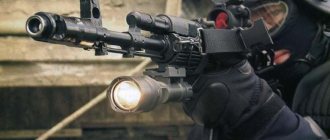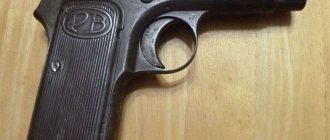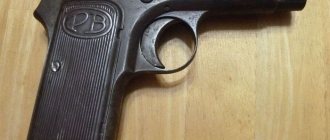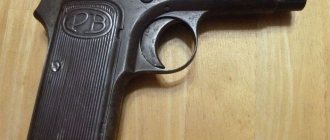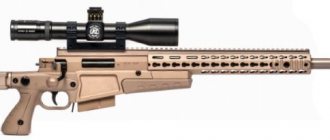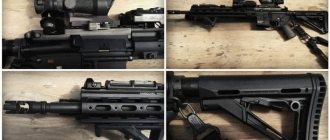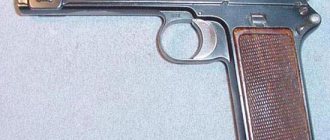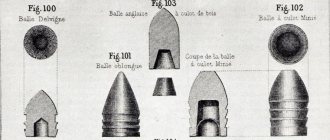Hello new Webley and Scott
The 2012 model is distinguished by high quality finishes.
It took some time to find a store with the most complete range of models presented; I finally succeeded, and, grabbing my camera, I went on my first date with the new Webley&Scott.
Today the situation in the arms market is difficult; The fact is that although the sanctions imposed by Europe do not prohibit the direct sale of hunting weapons and ammunition to Russia, many manufacturers have been advised to suspend supplies, and some are not issued export licenses. As a result, weapon prices went up, and the range, although slightly, decreased. In such a situation, the emergence of a new brand, and with such a history, can only be welcomed.
In the last article I mentioned that weapons for Webley&Scott are now manufactured in Turkish factories. As you know, production in Europe is now expensive, which leads to a general tendency to transfer it to countries with cheaper labor and other costs. England chose Turkey as a production site.
It should be noted that Turkey has proven itself well as a manufacturer of small arms. Today, Turkish arms factories produce both civilian and military weapons. Pistols, rifles and machine guns have been supplied to NATO for a long time and have earned respect and a positive image from the military. More than a hundred enterprises in Turkey have licenses to produce weapons and compete fiercely for new orders.
Add to this the pedantic English “acceptance”, and I think that you don’t have to worry about the quality of the finished products. Having dealt with Turkish guns, I have more than once been convinced of their quality and reliability; in most cases, the design of these guns is based on good old European developments and patents, usually with minor modifications due to the peculiarities of local production, and more often than not, marketing ideas.
| The removable chokes on the 2012 model do not have the characteristic key slots. |
The only thing that worried me was the price. Who will the new shotguns compete with? With the products of our manufacturers? With Turkish guns? Or maybe with brands such as Beretta, Benelli or, God forbid, Perazzi? Arriving at Okhotnik on Skolkovsky, I was convinced that the marketers from Webley&Scott do not eat their bread in vain, and the line of guns in the price range is very wide: from 24 to 110 thousand rubles.
As I was told, the main deliveries are expected in July-August; today a trial batch has arrived and been certified, which includes the most interesting and popular models offered by Webley&Scott.
I was greeted very warmly at the store and given the opportunity and time to familiarize myself with the new models in detail. Today there are four of them, for every taste and budget. As we remember, the Webley&Scott form does not give its own names to the models, but assigns them numbers; the guns are called “model 612” or “model 2012”. The models are made into series, according to the types of guns; so the 600 series are pump-action shotguns of several modifications, and the 2000 series are elite weapons, expensive, with high quality finishes.
I think it’s most logical to build a story about models from simple to complex, or rather, from affordable guns to elite, expensive ones.
| The pump-action shotgun already has a bar installed to protect your hands from burns. |
The tactical pump-action shotgun is the most affordable and most militarized of the models presented. The height of utility, steel and plastic. The company has combined the most common ideas today: a collapsible telescopic stock allows you to shoot with both the stock folded and choose the length of the stock that is most convenient for a particular shooter. There is a lot of debate about whether to make folding stocks on such weapons: sideways or upwards.
Practice has shown that the best option is a telescopic butt; This option makes it possible to make a weapon as short as possible by law - 80 cm, but at the same time retain the possibility of a shot. Professionals unanimously say that all the fuss with blockers does not lead to good.
The weapon should be designed as simply as possible and make it possible to open fire without unnecessary manipulations with the butt. It is generally unreasonable to make a weapon that, with the butt folded, is more than 80 cm long; when the butt is folded out, it turns into a real “oar”, of little use for tactical purposes.
| WEBLEY&SCOTT MOD. 612. Type: pump-action Barrel: 51 cm Stock material: plastic Caliber: 12x76 Weight: 2.8 kg Length: 103 cm Magazine: 5+1 Approximate. price: 24,000 rub. |
There are four holes on the butt, it’s a pity that I didn’t think to try on cartridges there, but my fingers fit in there, turning the butt into something like brass knuckles. I wonder if this is intended, or is it just my imagination? I liked the high sighting devices, with a fence, as expected on a tactical weapon, a high front sight with a luminous insert and a diopter rear sight, a convenient and practical combination that allows you to shoot quickly and accurately both in good light and in the twilight.
On the top of the box there is a “weaver” bar; a collimator fits perfectly on it. There is also a similar rail on the forend for an additional fire control handle or tactical flashlight. It’s very good that the basic package includes a barrel guard; it protects your hand from burns during intense shooting; For some reason, other manufacturers consider this detail superfluous, but it seems to me that for a tactical rifle it is simply mandatory.
The composition is completed by a very specific flame arrester, “toothy” and quite long; similar devices, together with a special cartridge, are used by American units to knock out door locks, it’s funny, but let it be, it looks very good and out of place.
| The appearance of the Model 612 is aggressive, as befits a tactical shotgun. |
The design of the pump action is also unusual, the locking is classic, with a wedge, but the spring that returns the forend forward is interesting. The spring is powerful, it not only helps to return the fore-end to its original position, it is capable of completely sending the cartridge without the help of the shooter. That is, after a shot, it is enough to pull the fore-end back and release, the next cartridge will be chambered independently, which is very unusual for a pump-action shotgun.
It is unlikely that such a weapon can be recommended for hunting, but as a weapon for self-defense or recreational shooting it is quite competitive.
Classic hunting semi-automatic, inertia. This means that the weapon does not have a gas outlet, there are no holes in the barrel, no pistons or other pushers, and the barrel does not move anywhere, like Browning clones. The device is simple to the point of genius. I really like inertial ones. Personal experience has shown that they are not only simple to set up and maintain, but also not capricious, they easily work on almost any cartridge with loads from 28 g, for 12 gauge. This feature, in my opinion, makes them an ideal weapon for both beginners and experienced shooters and hunters.
This is a real classic hunting semi-automatic with good design and ergonomics, beautiful deep black bluing of all steel parts except the bolt. The barrel is equipped with interchangeable chokes, which allows you to choose the right choke for any hunting and sporting tasks.
| A typical type of inertial semi-automatic machine is that the bolt does not seem to be closed, this feature gives them away at first sight. |
The gun is elegant and harmonious, the bolt moves very smoothly, the only thing you need to remember, like all inertial action guns, when closing the bolt you cannot accompany it with your hand, just pull the bolt back and release it, then the gun will do everything on its own as it should. If the closing is slow, the cylinder may not lock, and then the shot will not fire.
The finishing quality of the presented weapon is very good, the walnut, although not very expensive, is well processed and well fitted. The gun is pleasant to hold in your hands and you don’t want to let go. The balance is slightly shifted forward, but this is typical for all semi-automatic machines; on gas outlets it is even more pronounced.
In its price range - up to $1000 - I find this gun very attractive; Of course, I would like to see how it will perform at the shooting range, but I think it will find its place in the hunters’ arsenal.
A double-barreled shotgun with a vertical arrangement of barrels, 20 caliber, lightweight, one might even say elegant. The stock is made of good walnut, with a distinct “pistol” feel more typical of sporting shotguns. The end of the butt is closed with a rubber butt plate - a shock absorber. The sportiness of the gun is emphasized by one trigger; such a trigger is very good for a sports gun, but not very convenient for hunting, especially if the barrels contain cartridges with different shot numbers.
Of course, it is possible to switch the order of the barrels, but it seems to me that this is not very convenient for hunting. The safety is located on the neck of the butt, automatic, and turns on when the unlocking key is removed. The block of barrels is locked from below with two hooks; the device is simple and reliable.
The only thing that caught my eye was that when closing, the key must be turned manually, as on our new IZH-27 or TOZ-34; It is clear that this will pass over time, but there is some dissonance that with such careful finishing of the gun, the key remains, as it were, unfinished. Both barrels have interchangeable chokes, so either barrel can have any constriction. I can’t help but note the excellent welding and excellent bluing of the barrels - why can’t our factories bluing so that it’s deep, black, “in a mirror”?
The caliber was chosen very well, not just 12x70, but 12x76, this significantly expands the range of ammunition that can be used in the gun, which in turn brings the lightweight and convenient double-barreled shotgun closer in power to regular 12-gauge guns.
| Model 920 is a classic double-barreled shotgun with a vertical barrel arrangement. |
Elite double-barreled over/under, excellent quality walnut, colored paper on the box, gorgeous walnut and perfect wood fit. The gun is gorgeous, but the price is high; Of course, an elite weapon cannot be cheap, but it is still a production gun. Of course, the walnut is good and the excellent trunks are almost perfect, but even on the previous copy they are no worse. On the other hand, just a set of good nuts can cost more than 100 thousand rubles.
The 2012 model shotgun has all the attributes of an expensive, elite weapon, colored tracing on the box, the absence of a butt plate - a notch is applied to the cut of the butt. A weapon with such a stock always looks elegant and finished. The gun has one trigger and a non-automatic safety.
The interchangeable chokes are very interesting, they do not have key cutouts, these cutouts, in my opinion, spoil the appearance of the muzzle, they are unscrewed with a special “expanding” key. There was speculation that this could cause problems with the chokes sticking. Well, firstly, stuck classic chokes are not always possible to unscrew, and secondly, there is no need to bring the weapon to such a state.
Just two rules will allow you to never encounter such a problem: first, when cleaning, always unscrew and clean the chokes and their seats. Second, use graphite lubricant; it does not fade and is excellent at resisting sticking of chokes.
What conclusions can be drawn from learning about Webley&Scott weapons? It seems to me - the following: the quality of the presented samples is very high, even a relatively inexpensive pump is distinguished by careful finishing and a very good fit of parts.
Domestic weapons are clearly inferior to the presented samples, primarily in terms of external processing, and the internal finishing of the barrels on Webley looks much nicer. Of course, the MP-153 is noticeably cheaper, but its external finish cannot withstand any comparison with the 812 model. And if we talk about the device, then, in my opinion, the presented inertia device is much more interesting than a simple gas outlet. Double-barreled shotguns also give many points ahead to our MPs and TOZs.
Where can you find a lightweight over/under caliber 20x76 today? I saw the domestic MP-43 horizontal rifle in the store a couple of times, but it was assembled on the basis of a 12-gauge box and is not much different in weight from the original model. The Webley is just such a gun, with a vertical barrel arrangement, lightweight, it is ideally suited for hunting field birds. There are also lighter charges, and if necessary, it is quite possible to shoot with a magnum, which in its characteristics is very close to 12x70.
| A single trigger indicates the 2012 model's sporty stance. |
It should be noted that the listed models do not exhaust the company’s product range. It has both horizontal planes and dozens of variants of the presented models; let’s hope that all this variety will be available to us.
In a word, the weapon makes a very favorable impression, the quality of finishing and fit is excellent, the walnut is excellent and fully corresponds to the price. The most popular combinations of designs and calibers. All this makes Webley&Scott weapons interesting and in demand in our arms market.
Sergey Smolin July 30, 2014 at 00:00
story
The British company Webley & Scott (P. Webley & Son, before merging with W&C Scott 1897) produced a number of revolvers from the mid-19th to the late 20th century.
As early as 1853, P. Webley and J. Webley began producing their first patented single action cap and ball revolvers. Later under the trade name of P. Webley and Son, production included their own .44 caliber rim fire monolithic frame revolvers, as well as licensed copies of the Smith & Wesson break action revolvers. The quintessential hinged frame, center-of-fire revolvers for which the Webley name is best known first began production/development in the early 1870s primarily with the Webley-Pryse (1877) and Webley-Kaufman (1881) models. The RG or Webley-Government models, derived from 1885 to the early 1900s, (often erroneously referred to as Webley-Green) are the most popular of the commercial top-break revolvers and many were the private purchase choice of British officers and shooter targets during the period, coming to .476/.455 cal. However, other short barrel solid frame revolvers, including the Wel RIC (Royal Irish Constables model) and the British Bulldog revolver, designed to be carried in a coat pocket for self-defense were much more common during the period. Today, undoubtedly the most famous of these are the range of military revolvers, which have been in use through two world wars and numerous colonial conflicts. The Webley revolver went through a number of changes, leading to the Mk VI, which was in production between 1915 and 1923. The larger .455 Webley revolvers were withdrawn in 1947, although the Webley Mk IV .38/200 remained in service until 1963 along with the Enfield No. 2 Mk I revolver. Commercial versions of all Webley service revolvers have also been sold into the civilian market, along with a number of similar designs (such as the Webley-government
and
Webley-Wilkinson
) which were not officially adopted into service, but were nevertheless purchased confidentially by officers. Webley records show the last Mk VIs being sold from the factory in 1957 with "Nigeria" noted against entry.
Differences from predecessors
In fact, the design of the Webley Mk III was almost identical to the Mk II. The main innovation was the use of a more advanced drum lock switch from the Webley “WG” M 1892 revolver and a special lever with which the drum could be removed. Minor changes were also made to the frame guard and ejector lever, although these parts were still suitable for previous models of the Webley Mark series.
Structurally, the Webley Mk III was a revolver with a frame that broke off for reloading and simultaneous extraction of all cartridges.
The barrel had an upper rib and a boss at the muzzle with a permanent front sight.
The frame was locked using a fairly simple Green system lock, which looked like a U-shaped bracket, with an upper crossbar gripping the shank of the upper half of the frame. The lock was controlled by a lever on the left side of the frame, when pressed, the crossbar moved back and released the upper part of the frame. On the right side of the frame there was a V-shaped flat spring of the lock openly located. The design is designed so that until the latch is closed, the nose of the trigger cannot reach the cartridge primer.
The handle had a curved "bird's head" shape and a ring for a safety strap. The handle cheeks with fine notches are made of ebonite.
Literature
In English
- Chris Bishop.
Guns in Combat. - Chartwell Books, Inc., 1998. - ISBN 0-7858-0844-2. - William Chipchase Dowell.
The Webley Story. - Kirkland, WA (USA): Commonwealth Heritage Foundation, 1987. - ISBN 0-939683-04-0. - Gerard Henrotin.
The Webley service revolvers. - HLebooks.com, 2007. - Jeff Kinard.
Pistols: An Illustrated History of Their Impact. - ABC-CLIO, 2004. - ISBN 978-1-85109-470-7. - Robert J. Maze.
Howdah to High Power: A Century of Breechloading Service Pistols (1867–1967). - Tucson, AZ (USA): Excalibur Publications, 2002. - ISBN 1-880677-17-2. - Ian D. Skennerton.
List of Changes in British War Material in Relation to Edged Weapons, Firearms and Associated Ammunition and Accessories, Volumes I-IV. — Margate, Australia: HM Stationer's Office, 1993. - Ian D. Skennerton.
Small Arms Identification Series No. 9: .455 Pistol, Revolver No. 1 Mk VI. - Gold Coast, QLD, Australia: Arms & Militaria Press, 1997. - ISBN 0-949749-30-3. - W. H. B. Smith.
1943 Basic Manual of Military Small Arms (Facsimile). - Harrisburg, PA (USA): Stackpole Books, 1979. - ISBN 0-8117-1699-6. - Mark Stamps, Ian D. Skennerton.
.380 Enfield Revolver No. 2. - London (UK): Greenhill Books, 1993. - ISBN 1-85367-139-8. - Royce Wilson.
A Tale of Two Collectables (English) // Australian Shooter. — 2006. — March. - Dan Shideler.
// Gun Digest 2011. - 65. - Iola, WI: Krause Publications, 2011. - 568 p. — ISBN 978-1-4402-1561-2.
In Russian
- Chris Shant.
Infantry weapons: Encyclopedia of small arms / trans. from English S. Sumbaev, S. V. Shashkov. - M.: Omega, 2007. - 256 p. — 4000 copies. — ISBN 0785817212. - Will Fowler, Anthony North, Charles Stronge.
Encyclopedia of pistols, revolvers and machine guns. — Belgorod: Book Club “Family Leisure Club” LLC, 2014. - Ian Hogg, John Weeks.
All pistols in the world / Complete illustrated reference book of pistols and revolvers. - M.: Eksmo-Press, 1999. - ISBN 5-04-000401-X.
Recommendations
- Dowell, William Chipchase, The Webley History
, Commonwealth Heritage Trust, Kirkland, WA (USA), 1987. ISBN 0-939683-04-0. - HM Stationery Office, List of Changes in the British War Material
, HMSO, London (UK), magazine. - Maze, Robert J., Howdah to High Power: A Century of Breechloading Service Pistols (1867-1967)
, Excalibur Publications, Tucson, AZ (USA), 2002. ISBN 1-880677-17-2. - Skennerton, Ian D., Small Arms Identification Series No. 9: 0.455 Pistol, Revolver No. 1 Mk VI
, Weapons and Militaria Press, Gold Coast, QLD (Australia), 1997. ISBN 0-949749-30-3. - Smith, W.H.B., 1943 A Quick Guide to Military Small Arms
(facsimile), Stackpole Books, Harrisburg, Pennsylvania (USA), 1979. ISBN 0-8117-1699-6. - Mark, Mark and Skennerton, Ian D., .380 Enfield Revolver no.
2 , Greenhill Books, London (UK), 1993. ISBN 1-85367-139-8. - Wilson, Royce, “A Tale of Two Collectables,” Australian Shooter
Magazine, March 2006. - Gerard Henrotin, “Webley Revolver Servicers,” HLebooks.com
e-book download, 2007.
